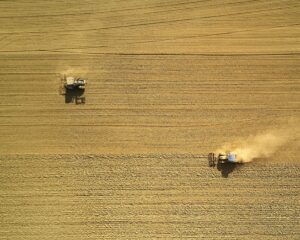The IoT landscape is constantly evolving around us. Here we take a look at some of the key sectors that it is affecting.
Technology has already changed the way we hail taxis, order our Friday night takeaways, and pay our bills without getting out of bed, but as the Internet of Things – combined with technologies like cloud, edge computing and AI – evolves to better serve businesses’ needs, we will see digital transformation across all kinds of sectors. Here’s a snapshot of a few industries that IoT will change for good.
Farming
 Over the years, inventions such as the seed drill, the plough and fertilisers have had a dramatic impact on the way many farmers operate – but data generated through enhanced connectivity and the use of IoT devices will ensure they can make the very most of what they produce.
Over the years, inventions such as the seed drill, the plough and fertilisers have had a dramatic impact on the way many farmers operate – but data generated through enhanced connectivity and the use of IoT devices will ensure they can make the very most of what they produce.
“Out in the fields, sensors in the earth will give farmers a far clearer picture of soil conditions and allow them to make better-informed decisions in order to increase crop yields.”
Similarly, sensors placed on livestock allow farmers to keep a closer eye on the health of their herds, picking up potential health problems before they have a chance to spread to other animals.
Construction
 Employees of major construction companies could be working on a new shopping centre in Spain one day and checking in on the progress of a state-of-the-art football stadium in Russia the next, which makes borderless connectivity essential to staying on top of things. They need to be able to access all company systems without clocking up huge roaming charges or running into connectivity issues, no matter which corner of the globe their work takes them to.
Employees of major construction companies could be working on a new shopping centre in Spain one day and checking in on the progress of a state-of-the-art football stadium in Russia the next, which makes borderless connectivity essential to staying on top of things. They need to be able to access all company systems without clocking up huge roaming charges or running into connectivity issues, no matter which corner of the globe their work takes them to.
“Meanwhile, IoT sensors can also enable previously impossible levels of monitoring, ensuring that structures maintain their integrity both in construction and afterwards, avoiding reliance on periodic inspections to catch potential problems and instead providing advance warnings of when maintenance work is required.”
This relies on affordable, low-demand, always-on connectivity no matter where in the world the project is.
Food and beverage logistics
Travelling can be an arduous enough process when you’re a human being strapped into a reclining seat, with a catalogue of films to watch and people on hand to serve you food and drink as and when required, so imagine what it’s like if you’re a tomato packed into a crate or a bottle of wine stowed away in a dark box.
 Any business that transports products internationally can benefit from better monitoring of the process, particularly when conditions on the journey can affect the quality of the cargo when it arrives at the other end.
Any business that transports products internationally can benefit from better monitoring of the process, particularly when conditions on the journey can affect the quality of the cargo when it arrives at the other end.
“IoT and borderless connectivity not only allow companies to keep track of the progress made by logistics vehicles, but sensors onboard can also monitor the temperature and condition of the cargo, ensuring that it’s transported correctly and arrives exactly as it left.”
In the wine making industry, for example, sensors in different parts of the vineyard could also give winemakers better insight into the health of their crops, the sugar levels in the grapes, and the conditions of the soil, to help ensure the high quality of wines each year.
Healthcare
Hospitals and healthcare facilities are veritable data factories, generating huge amounts of information on patients every single day. Appointments, test results, and patient monitoring systems all contribute to the torrent of information flowing out of each one, so as IoT devices become more sophisticated and widespread, and more medical equipment gets connected, there is an opportunity for medical and administrative staff to harness this data to improve the quality of care.
 Devices that remotely monitor a patient’s blood pressure, for example, and relay this information to a healthcare professional in real-time could help identify patterns and support treatment planning, as well as alert a nurse or doctor if severe issues emerge. Through new telehealth applications, IoT is also transforming healthcare in remote areas.
Devices that remotely monitor a patient’s blood pressure, for example, and relay this information to a healthcare professional in real-time could help identify patterns and support treatment planning, as well as alert a nurse or doctor if severe issues emerge. Through new telehealth applications, IoT is also transforming healthcare in remote areas.
Emergency services and maintenance
Most people use wearables to keep fit – but for someone with a dangerous job it could be the difference between life and death.
“In hazardous environments, IoT-enabled wearables, like sensors incorporated into protective clothing, can monitor workers’ fatigue and stress levels, particularly those who work with potentially dangerous equipment; ensure they’re not being exposed to harmful substances; or just track their location using GPS and keep them in regular contact with co-workers.”
 This is just a snapshot of the transformational potential of IoT – but they demonstrate that the capture, movement and management of IoT data, and leveraging this data for actionable insights, is only possible with reliable, secure connectivity. Increasingly, edge computing and AI are also being leveraged by businesses in IoT use cases to enable real-time data analytics for immediate decision making and action by the device itself.
This is just a snapshot of the transformational potential of IoT – but they demonstrate that the capture, movement and management of IoT data, and leveraging this data for actionable insights, is only possible with reliable, secure connectivity. Increasingly, edge computing and AI are also being leveraged by businesses in IoT use cases to enable real-time data analytics for immediate decision making and action by the device itself.
With Mobile World Congress 2020 just a few months away, my mobility and IT colleagues and I will be delving deeper into how different industries are harnessing the power of IoT, AI and edge computing to enhance operational efficiencies and open up new revenue streams. So watch this space…
Discover how technology is helping us live better and longer lives here.
Transformational Hybrid SolutionsOur cloud-enablement services offer the best performance on your traffic-heavy websites or mission-critical applications.
Core NetworksTata Communications™ global IT infrastructure and fibre network delivers the resources you need, when and where you need them.
Network Resources
Unified Communications As A ServiceBreak the barriers of borders efficiently and increase productivity with Tata Communications’ UC&C solutions.
Global SIP ConnectEmpower your business with our SIP network and witness it grow exponentially.
InstaCC™ - Contact Centre As A ServiceCloud contact centre solutions for digital customers experience and agent productivity.
Unified Communication Resources Case studies, industry papers and other interesting content to help you explore our unified communications solution better.
IoT SolutionsThe Internet of Things is transforming the way we experience the world around us for good. Find out more about our Internet Of Things related solutions here.
Mobility SolutionsTata Communications’ mobility services enable your enterprise to maintain seamless communication across borders, with complete visibility of cost and usage.
Mobility & IoT Resources
Multi-Cloud SolutionsWith enterprises transitioning to a hybrid multi-cloud infrastructure, getting the right deployment model that yields ROI can be a daunting task.
Cloud ComplianceCompliant with data privacy standards across different countries and is also designed to protect customers’ privacy at all levels.
IZO™ Cloud Platform & ServicesIZO™ is a flexible, one-stop cloud enablement platform designed to help you navigate complexity for more agile business performance.
Managed Infrastructure ServicesIntegrated with our integrated Tier-1 network to help your business grow efficiently across borders.
Cloud PartnersWe support a global ecosystem for seamless, secure connectivity to multiple solutions through a single provider.
Cloud Resources
Governance, Risk, and ComplianceRisk and Threat management services to reduce security thefts across your business and improve overall efficiencies and costs.
Cloud SecurityBest-in-class security by our global secure web gateway helps provide visibility and control of users inside and outside the office.
Threat Management - SOCIndustry-leading threat-management service to minimise risk, with an efficient global solution against emerging security breaches and attacks.
Advanced Network SecurityManaged security services for a predictive and proactive range of solutions, driving visibility and context to prevent attacks.
Cyber Security ResourcesCase studies, industry papers and other interesting content to help you explore our securtiy solution better.
Hosted & Managed ServicesTata Communications provide new models for efficient wholesale carrier voice service management. With our managed hosting services make your voice business more efficient and better protected
Wholesale Voice Transport & Termination ServicesYour long-distance international voice traffic is in good hands. End-to-end, voice access & carrier services which includes voice transport and termination with a trusted, global partner.
Voice Access ServicesTata Communication’s provide solutions which take care of your carrier & voice services, from conferencing to call centre or business support applications.
Carrier Services Resources
CDN Acceleration ServicesOur CDN Web Site Acceleration (WSA) solution helps deliver static and dynamic content, guaranteeing higher performance for your website.
CDN SecuritySafeguard your website data and customers’ information by securing your website from hacks and other mala fide cyber activities.
Video CDNDeliver high-quality video content to your customers across platforms – website, app and OTT delivery.
CDN Resources
Elevate CXIncrease customer satisfaction while empowering your service team to deliver world-class customer experience and engagement.
Live Event ServicesTata Communications’ live event services help battle the share if eyeballs as on-demand video drives an explosion of diverse content available on tap for a global audience.
Media Cloud Infrastructure ServicesTata Communications’ media cloud infrastructure offers flexible storage & compute services to build custom media applications.
Global Media NetworkTata Communications’ global media network combines our expertise as a global tier-1 connectivity provider with our end-to-end media ecosystem.
Use CasesUse cases of Tata Communications’ Media Entertainment Services
Remote Production SolutionsMedia contribution, preparation and distribution are highly capital-intensive for producers of live TV and video content, and their workflows are complex.
Media Cloud Ecosystem SolutionsThe Tata Communications media cloud infrastructure services offer the basic building blocks for a cloud infrastructure-as-a-service.
Global Contribution & Distribution SolutionsTata Communications’ global contribution and distribution solution is built to reduce capital outlay and grow global footprint.
Satellite Alternative SolutionsAs more and more consumers choose to cut the cord & switch to internet-based entertainment options, broadcasters are faced with capital allocation decisions.
LeadershipA look into the pillars of Tata communications who carry the torch and are living embodiment of Tata’s values and ethos.
Culture & DiversityHere at Tata Communications we are committed to creating a culture of openness, curiosity and learning. We also believe in driving an extra mile to recognize new talent and cultivate skills.
OfficesA list of Tata Communications office locations worldwide.
FAQCheck out our FAQs section for more information.
SustainabilityOur holistic sustainability strategy is grounded in the pillars of People, Planet and Community with corporate governance at the heart of it.
BoardHave a look at our board of members.
ResultsFind out more about our quarterly results.
Investor PresentationsFollow our repository of investor presentations.
FilingsGet all information regarding filings of Tata communications in one place.
Investor EventsAll investor related event schedule and information at one place.
GovernanceAt Tata, we believe in following our corporate social responsibility which is why we have set up a team for corporate governance.
SharesGet a better understanding of our shares, dividends etc.
SupportGet all investor related contact information here.




